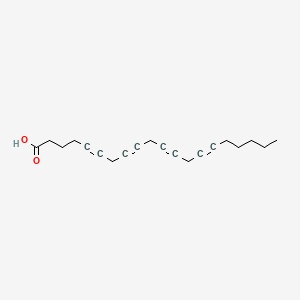| Li XC et al. |
Potent in vitro antifungal activities of naturally occurring acetylenic acids. |
2008 |
Antimicrob. Agents Chemother. |
pmid:18458131
|
| Maher M et al. |
Activation of TRPA1 by farnesyl thiosalicylic acid. |
2008 |
Mol. Pharmacol. |
pmid:18171730
|
| Giuliani C et al. |
The flavonoid quercetin regulates growth and gene expression in rat FRTL-5 thyroid cells. |
2008 |
Endocrinology |
pmid:17962351
|
| Yaghini FA et al. |
Expression and mechanism of spleen tyrosine kinase activation by angiotensin II and its implication in protein synthesis in rat vascular smooth muscle cells. |
2007 |
J. Biol. Chem. |
pmid:17442668
|
| Zhao ZG et al. |
Flufenamic acid bi-directionally modulates the transient outward K(+) current in rat cerebellar granule cells. |
2007 |
J. Pharmacol. Exp. Ther. |
pmid:17405868
|
| Scherer GF et al. |
A role for phospholipase A in auxin-regulated gene expression. |
2007 |
FEBS Lett. |
pmid:17692850
|
| Nandigama R et al. |
Feed forward cycle of hypotonic stress-induced ATP release, purinergic receptor activation, and growth stimulation of prostate cancer cells. |
2006 |
J. Biol. Chem. |
pmid:16321972
|
| Surin AM et al. |
Arachidonic acid enhances intracellular [Ca2+]i increase and mitochondrial depolarization induced by glutamate in cerebellar granule cells. |
2006 |
Biochemistry Mosc. |
pmid:16978149
|
| Berg C et al. |
Platelet-induced growth of human fibroblasts is associated with an increased expression of 5-lipoxygenase. |
2006 |
Thromb. Haemost. |
pmid:17080223
|
| Tamura K et al. |
Relationship between prostaglandin E2 and vascular endothelial growth factor (VEGF) in angiogenesis in human vascular endothelial cells. |
2006 |
Vascul. Pharmacol. |
pmid:16651031
|
| Liu Q et al. |
NADPH oxidase produces reactive oxygen species and maintains survival of rat astrocytes. |
2005 Mar-Apr |
Cell Biochem. Funct. |
pmid:15386527
|
| Li F and Malik KU |
Angiotensin II-induced Akt activation is mediated by metabolites of arachidonic acid generated by CaMKII-stimulated Ca2(+)-dependent phospholipase A2. |
2005 |
Am. J. Physiol. Heart Circ. Physiol. |
pmid:15637121
|
| Guizy M et al. |
{Omega}-3 and {omega}-6 polyunsaturated fatty acids block HERG channels. |
2005 |
Am. J. Physiol., Cell Physiol. |
pmid:15987770
|
| Yoon JH and Baek SJ |
Molecular targets of dietary polyphenols with anti-inflammatory properties. |
2005 |
Yonsei Med. J. |
pmid:16259055
|
| Bekar LK et al. |
Complex expression and localization of inactivating Kv channels in cultured hippocampal astrocytes. |
2005 |
J. Neurophysiol. |
pmid:15738276
|
| Rousseau E et al. |
Capsazepine, a vanilloid antagonist, abolishes tonic responses induced by 20-HETE on guinea pig airway smooth muscle. |
2005 |
Am. J. Physiol. Lung Cell Mol. Physiol. |
pmid:15557084
|
| Schmidt R et al. |
The cysteinyl-leukotriene-1 receptor antagonist zafirlukast is a potent secretagogue in rat and human airways. |
2005 |
Eur. J. Pharmacol. |
pmid:16310765
|
| Jozefowski S et al. |
Leukotrienes modulate cytokine release from dendritic cells. |
2005 |
Immunology |
pmid:16313356
|
| Dainese E et al. |
Structural stability of soybean lipoxygenase-1 in solution as probed by small angle X-ray scattering. |
2005 |
J. Mol. Biol. |
pmid:15876374
|
| Hamiduzzaman MM et al. |
beta-Aminobutyric acid-induced resistance against downy mildew in grapevine acts through the potentiation of callose formation and jasmonic acid signaling. |
2005 |
Mol. Plant Microbe Interact. |
pmid:16134894
|
